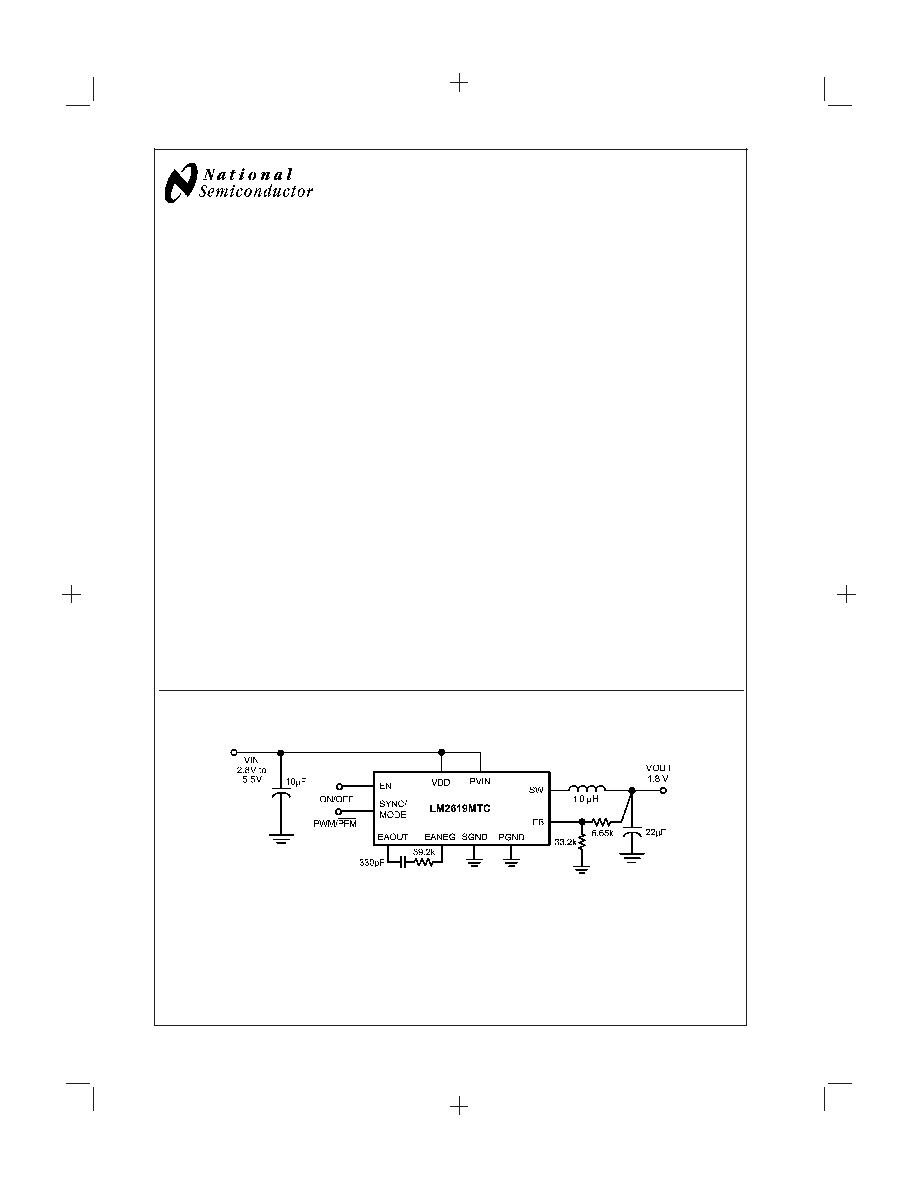
LM2619MTC
500mA Step-Down DC-DC Converter
General Description
The LM2619MTC step down DC-DC converter is optimized
for powering circuits from a single Lithium-Ion cell. It steps
down an input voltage of 2.8V to 5.5V to an output of 1.5V to
3.6V at up to 500mA. Output voltage is set using resistor
feedback dividers.
The device offers three modes for mobile phones and similar
portable applications. Fixed-frequency PWM mode mini-
mizes RF interference. A SYNC input allows synchronizing
the switching frequency in a range of 500kHz to 1MHz. Low
current hysteretic PFM mode reduces quiescent current to
160µA (typ). Shutdown mode turns the device off and re-
duces battery consumption to 0.02µA (typ.).
Current limit and thermal shutdown features protect the de-
vice and system during fault conditions.
The LM2619MTC is available in a 14 pin TSSOP package. A
high switching frequency (600kHz) allows use of tiny
surface-mount components.
The device features external compensation to tailor the re-
sponse to a wide range of operating conditions.
Key Specifications
n
Operates from a single LiION cell (2.8V to 5.5V)
n
Output voltage range of 1.5V to 3.6V
n
±
2% DC feedback voltage precision
n
500mA maximum load capability
n
600µA typ PWM mode quiescent current
n
0.02µA typ shutdown current
n
600kHz PWM switching frequency
n
SYNC input for PWM mode frequency synchronization
from 500kHz to 1MHz
n
High efficiency (Up to 95%) in PWM mode from internal
synchronous rectification
n
100% Maximum Duty Cycle for Lowest Dropout
Features
n
14-pin TSSOP package
n
Uses small ceramic capacitors
n
5mV typ PWM mode output voltage ripple(C
OUT
= 22µF)
n
Internal soft start
n
Current overload protection
n
Thermal Shutdown
n
External compensation
Applications
n
Mobile Phones
n
Hand-Held Radios
n
RF PC Cards
n
Wireless LAN Cards
Typical Application Circuits
20065101
FIGURE 1. Typical Circuit for 1.8V Output Voltage
August 2003
LM2619MTC
500mA
Step-Down
DC-DC
Converter
LM2619MTC
© 2003 National Semiconductor Corporation
DS200651
www.national.com
PrintDate=2003/08/20 PrintTime=18:54:04 801627bc ds200651_p Rev. No. 1.25
cmserv
Proof
Seq=1
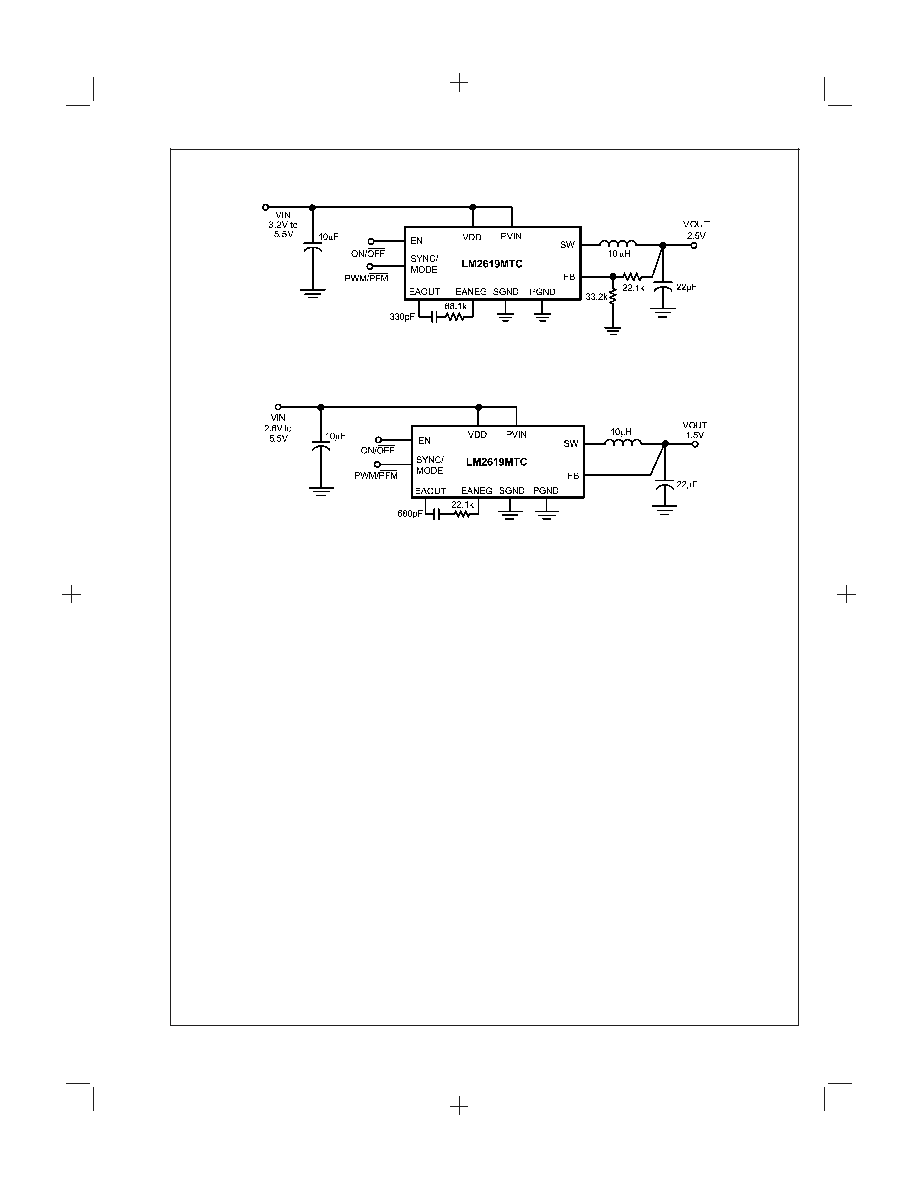
Typical Application Circuits
(Continued)
20065102
FIGURE 2. Typical Circuit for 2.5V Output Voltage
20065103
FIGURE 3. Typical Circuit for 1.5V Output Voltage
LM2619MTC
www.national.com
2
PrintDate=2003/08/20 PrintTime=18:54:04 801627bc ds200651_p Rev. No. 1.25
cmserv
Proof
Seq=2
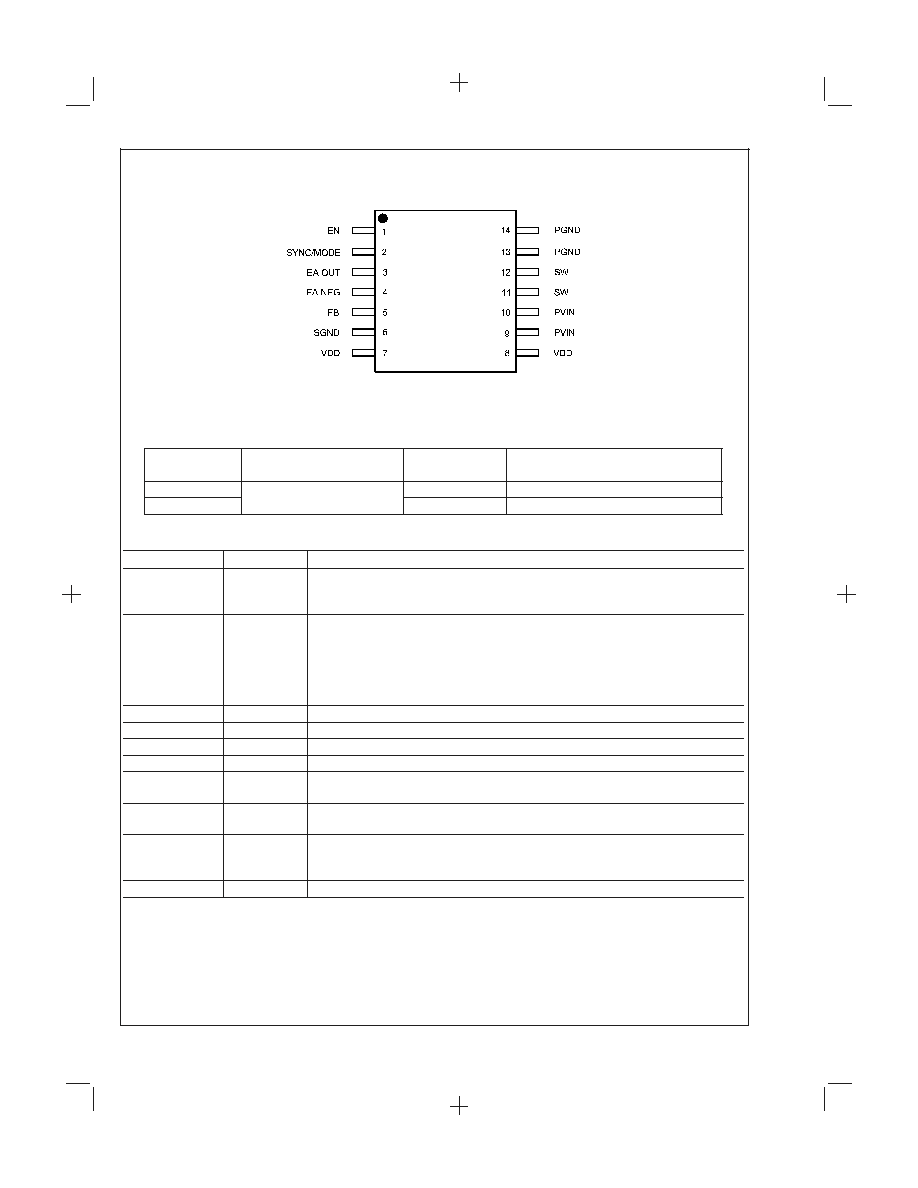
Connection Diagrams
14-Pin TSSOP
20065104
Top View
Ordering Information
Order Number
Package Type
NSC Package
Drawing
Supplied As
LM2619MTC
TSSOP - 14
MTC14
94 Rail
LM2619MTCX
MTC14
2500 Tape and Reel
Pin Description
Pin Number
Pin Name
Function
1
EN
Enable Input. Set this Schmitt trigger digital input high for normal operation. For shutdown,
set low. Set EN low during system power-up and other low supply voltage conditions.
(See Shutdown Mode in the Device Information section.)
2
SYNC/MODE
Synchronization Input. Use this digital input for frequency selection or modulation control.
Set:
SYNC/MODE = high for low-noise 600kHz PWM mode
SYNC/MODE = low for low-current PFM mode
SYNC/MODE = a 500kHz≠1MHz external clock for synchronization in PWM mode. (See
Synchronization and Operating Modes in the Device Information section.)
3
EAOUT
Output of error amplifier.
4
EANEG
Inverting Input of Error Amplifier.
5
FB
Feedback Analog Input.
6
SGND
Analog and Control Ground.
7,8
VDD
Analog Supply Input. If board layout is not optimum, an optional 0.1µF ceramic capacitor
is suggested from this pin to SGND.
9,10
PVIN
Power Supply Voltage Input to the internal PFET switch. Connect to the input filter
capacitor.
11,12
SW
Switching Node connection to the internal PFET switch and NFET synchronous rectifier.
Connect to an inductor with a saturation current rating that exceeds the max Switch Peak
Current Limit of the LM2619MTC.
13,14
PGND
Power Ground.
LM2619MTC
www.national.com
3
PrintDate=2003/08/20 PrintTime=18:54:04 801627bc ds200651_p Rev. No. 1.25
cmserv
Proof
Seq=3
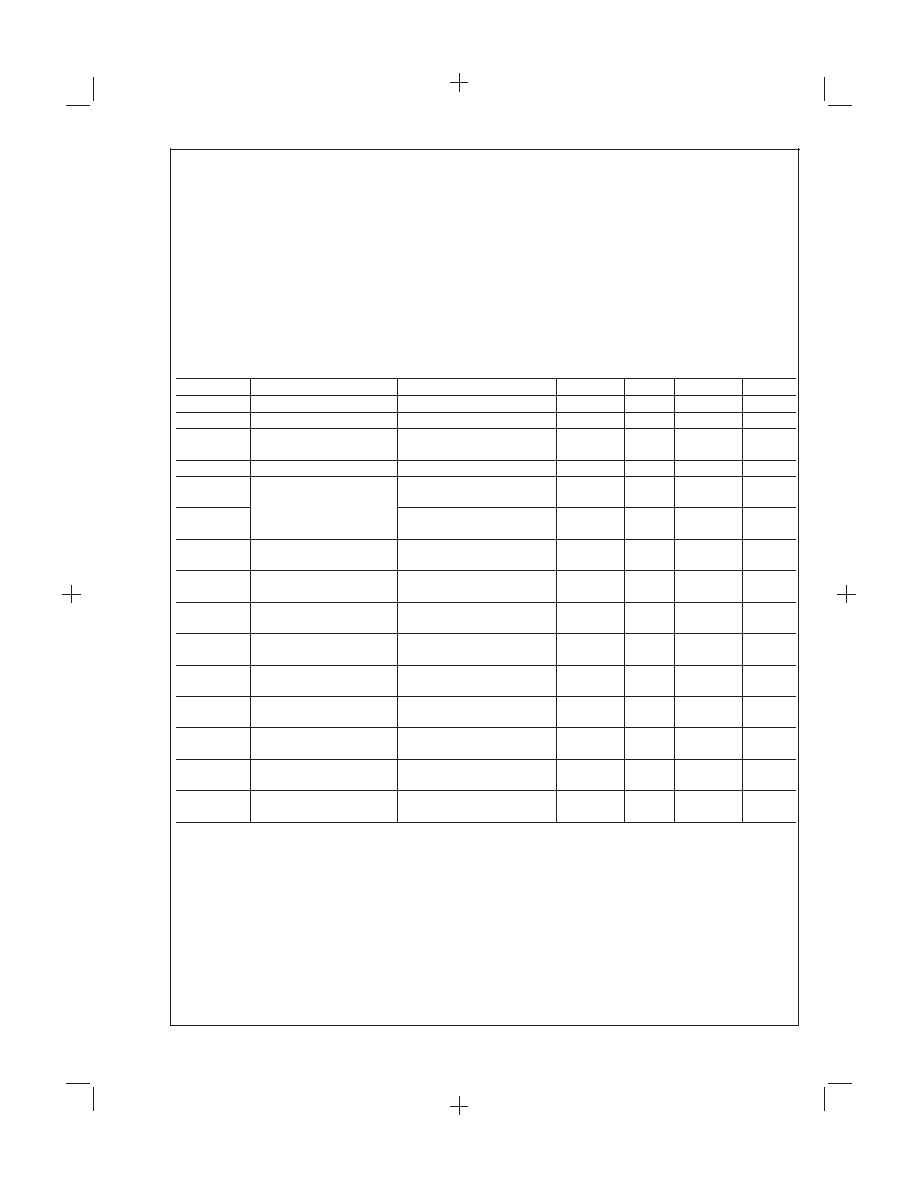
Absolute Maximum Ratings
(Note 1)
If Military/Aerospace specified devices are required,
please contact the National Semiconductor Sales Office/
Distributors for availability and specifications.
PVIN, VDD to SGND
-0.2V to +6V
PGND to SGND, PVIN to VDD
-0.2V to +0.2V
EN, EAOUT, EANEG, SYNC/MODE
to SGND
-0.2V to +6V
FB, SW
(GND -0.2V) to
(VDD +0.2V)
Storage Temperature Range
-45∞C to +150∞C
Lead Temperature
(Soldering, 10 sec.)
300∞C
Junction Temperature (Note 2)
+125∞C
Ambient Temperature Range
-25∞C to 85∞C
Minimum ESD Rating
±
2 kV
(Human Body Model, C = 100 pF, R = 1.5 k
)
Thermal Resistance (
JA
) (Note 3)
110∞C/W
Electrical Characteristics
Specifications with standard typeface are for T
A
= 25∞C, and those in boldface type apply over the full Operating Junction
Temperature Range of T
J
= -25∞C to +125∞C. Unless otherwise specified, PVIN = VDD = EN = SYNC/MODE = 3.6V.
Symbol
Parameter
Conditions
Min
Typ
Max
Units
V
IN
Input Voltage Range
PVIN = VDD = V
IN
(Note 4)
2.8
3.6
5.5
V
V
FB
Feedback Voltage
1.470
1.50
1.530
V
V
HYST
PFM Comparator Hysteresis
Voltage
PFM Mode (SYNC/MODE =
0V) (Note 5)
29
mV
I
SHDN
Shutdown Supply Current
VIN = 3.6V, EN = 0V
0.02
0.3
µA
I
Q1_PWM
DC Bias Current into VDD
SYNC/MODE = VIN
FB = 2V
600
725
µA
I
Q2_PFM
SYNC/MODE = 0V
FB = 2V
160
195
µA
R
DSON (P)
Pin-Pin Resistance for
P FET
(Note 6)
500
630
m
R
DSON (N)
Pin-Pin Resistance for
N FET
(Note 6)
420
550
m
R
DSON (TC)
FET Resistance
Temperature Coefficient
0.5
%/C
I
LIM
Switch Peak Current Limit
(Note 7)
620
850
1100
mA
V
IH
Logic High Input, EN,
SYNC/MODE
0.95
1.3
V
V
IL
Logic Low Input, EN,
SYNC/MODE
0.4
0.80
V
F
SYNC
SYNC/MODE Clock
Frequency Range
(Note 8)
500
1000
kHz
F
OSC
Internal Oscillator
Frequency
PWM Mode
468
640
800
kHz
T
min
Minimum ON-Time of PFET
Switch in PWM Mode
200
ns
Note 1: Absolute Maximum Ratings indicate limits beyond which damage to the device may occur. Operating Ratings indicate conditions for which the device is
functional, but device specifications may not be guaranteed. For guaranteed specifications and associated test conditions, see the Min and Max limits and Conditions
in the Electrical Characteristics table. Typical (typ) specifications are mean or average values at 25∞C and are not guaranteed.
Note 2: Thermal shutdown will occur if the junction temperature exceeds 150∞C.
Note 3: Thermal resistance specified with 4" x 3" JEDEC (2 layer 2 oz Cu.) board.
Note 4: The LM2619MTC is designed for mobile phone applications where turn-on after system power-up is controlled by the system controller. Thus, it should be
kept in shutdown by holding the EN pin low until the input voltage exceeds 2.8V.
Note 5: The hysteresis voltage is the minimum voltage swing on the FB pin that causes the internal feedback and control circuitry to turn the internal PFET switch
on and then off during PFM mode. When resistor dividers are used like in the operating circuit of Figure 4, the hysteresis at the output will be the value of the
hysteresis at the feedback pin times the resistor divider ratio. In this case, 24mV (typ) x ((46.4k + 33.2k)/33.2k).
Note 6: R
DSON
is specified by having the two PVIN pins connected together,two PGND pins connected together and the two SW pins connected together.
Note 7: Current limit is built-in, fixed, and not adjustable. If the current limit is reached while the voltage at the FB pin is pulled below 0.7V, the internal PFET switch
turns off for 2.5µs to allow the inductor current to diminish.
Note 8: SYNC driven with an external clock switching between V
IN
and GND. When an external clock is present at SYNC; the IC is forced to be in PWM mode at
the external clock frequency. The LM2619MTC synchronizes to the rising edge of the external clock.
LM2619MTC
www.national.com
4
PrintDate=2003/08/20 PrintTime=18:54:05 801627bc ds200651_p Rev. No. 1.25
cmserv
Proof
Seq=4
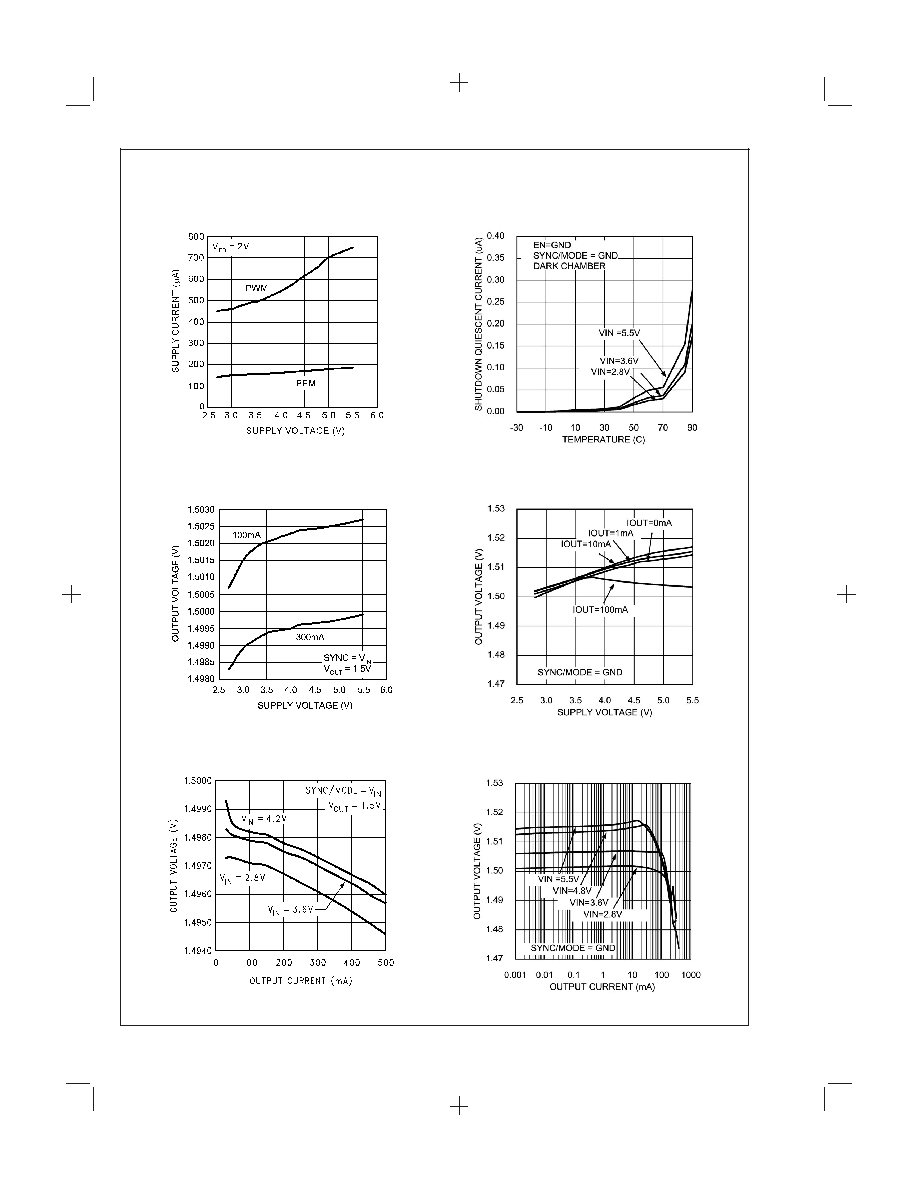
Typical Performance Characteristics
LM2619MTC, Circuit of Figure 3, V
IN
= 3.6V, T
A
= 25∞C, un-
less otherwise noted.
Quiescent Supply Current vs Supply Voltage
Shutdown Quiescent Current vs Temperature
(Circuit in Figure 3)
20065108
20065122
Output Voltage vs Supply Voltage
(V
OUT
= 1.5V, PWM MODE)
Output Voltage vs Supply Voltage
(V
OUT
= 1.5V, PFM MODE)
20065109
20065110
Output Voltage vs Output Current
(V
OUT
= 1.5V, PWM MODE)
Output Voltage vs Output Current
(V
OUT
= 1.5V, PFM MODE)
20065111
20065113
LM2619MTC
www.national.com
5
PrintDate=2003/08/20 PrintTime=18:54:05 801627bc ds200651_p Rev. No. 1.25
cmserv
Proof
Seq=5




